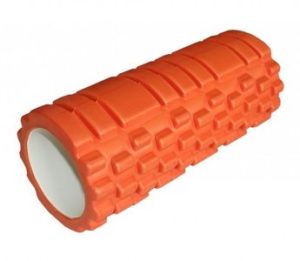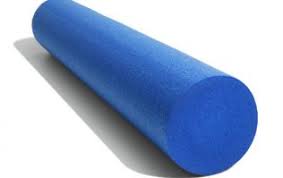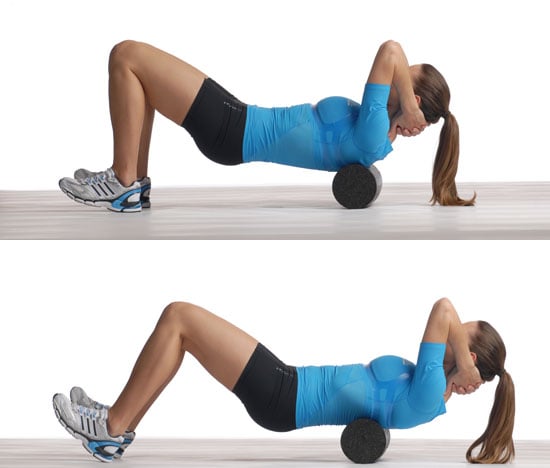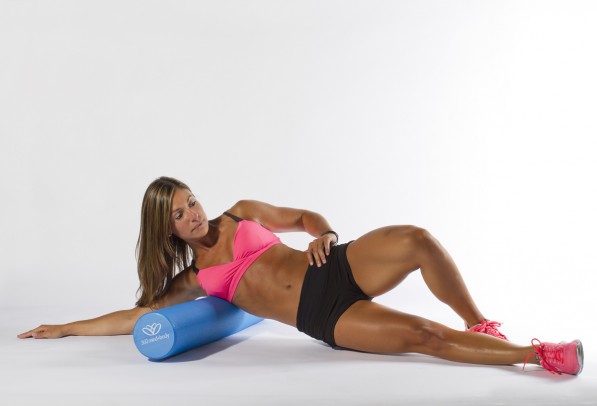These five movements are the foundation of using a foam roller.
 Number 1 – Lower Leg. The lower leg, or calf, influences how the rest of the body moves. “The head can be out of ideal alignment because the ankle isn’t moving correctly”, Stull says. Roll the lower leg and you may get relief from foot pain, improve knee tracking, and reduce tension in the hip, low back, shoulders neck and head.
Number 1 – Lower Leg. The lower leg, or calf, influences how the rest of the body moves. “The head can be out of ideal alignment because the ankle isn’t moving correctly”, Stull says. Roll the lower leg and you may get relief from foot pain, improve knee tracking, and reduce tension in the hip, low back, shoulders neck and head.
Technique: Sit on a flat surface with both legs outstretched. Supporting yourself on the hands, which should be next to the hip with fingertips out, place one leg on the roller, with the roller just above the ankle. Hold yourself off the ground and roll slowly (one inch per second) up to just below the calf and back down, four times. Set your hips back on the ground and then, with the roller just below the calf, roll your leg slowly from side to side in a spanning motion, also four times. Repeat the cycle on the part of your lower leg from just below the calf to just below the knee. Repeat the cycle with your other leg.
 Number 2 – Upper Leg. The upper leg, which includes the quads, plays an important role in the tracking of the knee and in hip function. Rolling the upper leg can help reduce tension in the quads, improve core stability and increase blood flow (and function) in the hips.
Number 2 – Upper Leg. The upper leg, which includes the quads, plays an important role in the tracking of the knee and in hip function. Rolling the upper leg can help reduce tension in the quads, improve core stability and increase blood flow (and function) in the hips.
Technique: Like the lower leg, you’ll roll the upper leg in two separate zones: just above the kneecap to the center thigh, and from the center thigh to just below the hip. Lay face down, supporting yourself on your forearms (hands spread out) with one leg on the ground and the other on the roller at the top of the kneecap. Roll slowly to the center thigh and back four times. With the roller at mid-thigh, bend your leg at the knee to 90 degrees four times. Repeat the cycle on the upper part of the leg and then on the other leg.
 Number 3 – Glutes and Hip. The glutes, commonly known as your butt, take a beating when you sit on them all day. “Several studies have shown that if the glutes can’t fire symmetrically it’ll alter the position of the low back and lead to pain”, Stull says. The glutes also control and knee, so rolling them out can potentially offer benefits across several parts of the body.
Number 3 – Glutes and Hip. The glutes, commonly known as your butt, take a beating when you sit on them all day. “Several studies have shown that if the glutes can’t fire symmetrically it’ll alter the position of the low back and lead to pain”, Stull says. The glutes also control and knee, so rolling them out can potentially offer benefits across several parts of the body.
Technique: Sit down on the roller with it positioned under the center of the hip on one side; on that same side, the leg and arm should be outstretched for support (on the other side, the leg can be bent with the foot flat on the ground the hand resting on the knee). Roll down a few inches (such that roller is moving toward your back) and back, four times. Back in the starting position, shift (in a dragging motion) your hips back and forth laterally across the roller four times. Now, position the roller below the hip again and slowly lower yourself so you’re flat on the ground, positioning the opposite leg up and over (as if you were stretching your lower back), such that your hips are stacked. Perform a spanning motion, moving the opposite leg back to up to 90 degrees and then across your body again. Repeat four times.
 Number 4 – Thoracic Spine. The thoracic spine is the mid- to upper-back, running the length of the rib cage, and it plays an important role in how our arms move and in our breathing, among other things. “People are big on dynamic warm-ups, but what we often forget is that the body is going to move through its available range of motion”, Stull says. “So if the thoracic spine is stuck, we have to understand that the motion isn’t just going to come back automatically.”
Number 4 – Thoracic Spine. The thoracic spine is the mid- to upper-back, running the length of the rib cage, and it plays an important role in how our arms move and in our breathing, among other things. “People are big on dynamic warm-ups, but what we often forget is that the body is going to move through its available range of motion”, Stull says. “So if the thoracic spine is stuck, we have to understand that the motion isn’t just going to come back automatically.”
Technique: To work the thoracic spine, lie in your back and position the foam roller at the bottom of the rib cage. Put your hands behind your head to support it. Lift your hips off the ground and roll forward on the roller until it’s at your shoulder blades, then back, repeating four times. With the roller at the bottom of the shoulder blades and your hips back on the ground, slowly bend your torso to the left and the right four times, creating a dragging motion across the muscles. Repeat the entire cycle, rolling from the bottom of the shoulder blades to the top of the shoulders.
 Number 5 – Lats/Side Torso. The lats are the largest muscles in the back, important to movement in the shoulder blade, thoracic spine, lumbar spine and hips, and have a major influence over the body, Stull says. Tight lats leave you in the slouched position you see desk jockeys in; rolling them out can give you better mobility from the shoulders to the hips.
Number 5 – Lats/Side Torso. The lats are the largest muscles in the back, important to movement in the shoulder blade, thoracic spine, lumbar spine and hips, and have a major influence over the body, Stull says. Tight lats leave you in the slouched position you see desk jockeys in; rolling them out can give you better mobility from the shoulders to the hips.
Technique: Lay on your side with hips, knees and feet stacked up on top of each other, with the hips and knees slightly bent. Outstretch the arm you’re rolling on the ground with your palm facing up; with the other arm, reach across your body and grip the roller. Roll up and down on the part of the lat muscle below the shoulder blade four times. Now take the arm your working and reach out in directly in front of your body. Then swing it slowly out until it’s in line with your body and bring it back to the starting position, repeating four times. Do this same cycle, but with the foam roller positioned on the upper part of the lat near your armpit.